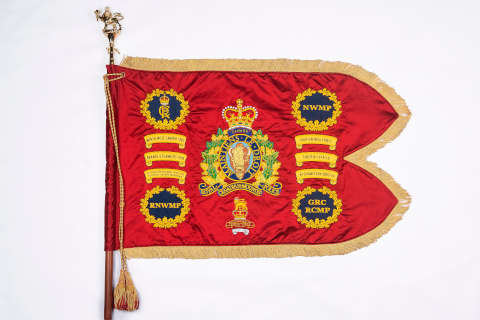Guidon
Quick facts
- Historically, special flags known as "Colours" marked and provided a rallying point for army regiments in the line of battle. Today, they are no longer carried in action or held by a unit in a theatre of war. They continue, however, as visible symbols of pride, honour and devotion to Sovereign and country. As such they are an organization's most prized possession.
- Unique among police organizations, the RCMP possesses its own Colour. Following the traditions of light cavalry, the RCMP's Colour is known as the "Guidon".
- The term "Guidon" comes from an old French word, "guy-d'homme", which refers to the flag carried by a cavalry leader.
- The first Guidon was presented to the RCMP by His Excellency, the Earl of Bessborough, Governor General of Canada in Regina, Saskatchewan, in April 1935.
Overview
The RCMP's Guidon is its regimental colour and is based on the tradition of British Army light cavalry regiments.
The first RCMP Guidon was consecrated in 1935. It was retired in 1973, when Her Majesty Queen Elizabeth II, the then-Honorary Commissioner of the RCMP, consecrated the second Guidon in Regina, Saskatchewan on the occasion of our 100th anniversary.
Following the coronation of King Charles III, a new Guidon was approved. It will be consecrated and presented on September 8, 2023 at Depot in Saskatchewan. The Guidon is emblazoned with the Royal Cypher of His Majesty King Charles III, King of Canada and Commissioner-in-Chief of the RCMP. It also bears the Corps Operational Honours that attest to the service of the RCMP in wartime, as well as the RCMP's role in support of peace-support operations in conflict zones. The abbreviation "GRC" appears for the first time symbolizing 150 years of service to Canadians in both Official Languages.
Transportation and escort
The Guidon Party is a small unit, consisting of a bearer, armed escorts and an orderly, that carries the Guidon on parade. Following tradition and decree by His Majesty King George IV in 1822, the bearer is always a warrant officer.
During transport, the Guidon must be safely stored and personally escorted by a warrant officer of the RCMP.
Parade
The Guidon is always paraded by itself or with other military colours only. It may not be paraded with other flags or ensigns.
The Guidon may be paraded:
- on the Sovereign's birthday
- at the funeral of a dignitary entitled to a 100-member guard of honour
- at a change of command ceremony for a new commissioner
- at a ceremonial commissioner's inspection parade
- at an RCMP memorial church service and parade honouring members who have died in the line of duty
- at other mounted/dismounted ceremonial parades as approved by the Commissioner
Features
The Guidon features the RCMP's regimental badge, the King's Royal Cypher and the abbreviations of the name at various times:
- NWMP (North-West Mounted Police)
- RNWMP (Royal North-west Mounted Police)
- RCMP GRC (Royal Canadian Mounted Police - Gendarmerie royale du Canada)
The Guidon also bears the RCMP's Corps Operational Honours indicating the theatres of military and civilian operations in which members served:
- North West Canada 1885
- South Africa 1900-2
- France and Flanders 1918
- Siberia 1918-19
- Second World War – Guerre Mondiale 1939-45
- Canadian Provost Corps 1939-45 Honorary Distinction
- Afghanistan 2003-14
The first and second Guidons are laid up in the RCMP Chapel in Regina, Saskatchewan, while the current one is displayed at the RCMP's National Headquarters in Ottawa, Ontario.
The Guidon embodies the honour and sacrifice made of all members of the RCMP, and is treated with extreme reverence. It is paid compliments (saluted) by all who enter its presence, or when it passes by on a parade. The only exception is when it is paraded at a funeral, where compliments are reserved for the deceased.
- Date modified:
